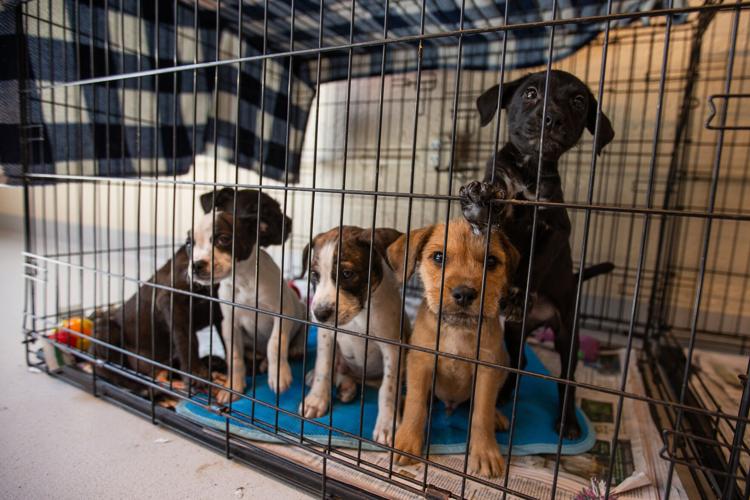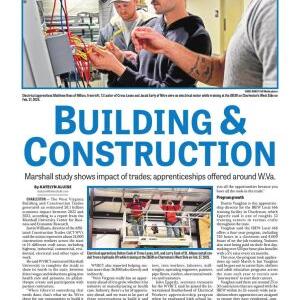HUNTINGTON — As it continues to determine what a reduction in funding from the City of Huntington will mean for its operations, the Huntington Cabell Wayne Animal Control Shelter has asked its community for additional support.
Following hours of public comment from people urging against the cut, Huntington City Council members on March 24 approved a Fiscal Year 2026 budget that includes $250,000 in contributions for the animal shelter — $50,000 more than Mayor Patrick Farrell proposed in his initial budget but $150,000 less than they got in FY25.
“I was appreciative of the compromise,” the shelter’s executive director, Courtney Proctor Cross, said. “It will be challenging to overcome the reduction of the funds from the city, but we’re already starting to work on fundraising.”
While the shelter always fundraises throughout the year, a current campaign asks people to sign up for monthly donations to close the funding gap.
“We’re trying to explain to our supporters in the community that, while it will be challenging, that we appreciate the mayor’s commitment to helping us keep the shelter a no-kill shelter,” Proctor Cross said. “We look forward to working together to overcome funding shortfalls and finding solutions to work through the challenges that this will present.”
How the loss of $150,000 will affect the shelter is unclear at the moment. Proctor Cross said her biggest concern is not being able to keep as many staff members as it needs to provide the desired quality of care for animals. The current fundraising campaign will paint a clearer picture on where the cuts will be directed. For now, the shelter will do the best it can for as long it can, Proctor Cross said.
The shelter usually has 15 people working a day, such as the people taking care of the dogs, taking care of the cats, the animal control officers and the people in the office, Proctor Cross said. Its biggest expense is paying staff and keeping up with feeding the animals, which Proctor Cross said donations help with but usually don’t cover.
Several employees and Proctor Cross’ salaries are paid through the Western West Virginia Animal Rescue Alliance (WWVARA), an independent nonprofit. Its primary purpose is to support the Huntington Cabell Wayne Animal Shelter, according to the animal shelter’s website. WWVARA’s status makes it possible for supporters to make tax-deductible donations.
Proctor Cross said the shelter has been looking for ways to reduce costs. The animal shelter’s new surgical unit, veterinarian and veterinarian technician are expected to save the animal shelter money; however, she said it’s too early to tell how much.
Another challenge is the shelter’s vehicles, which Proctor Cross described as old with high mileage, and often in need of repairs, which range from a couple hundred dollars to $1,500.
Operating costs
It costs the shelter anywhere from $1.3 million to $1.4 million a year to operate the main shelter and the Cook School building, Proctor Cross said.
All the entities represented by the animal control board members increased allocations for the current fiscal year because the shelter was operating in a deficit for months. According to the shelter’s profit and loss report for July through November 2024, the shelter reported a net income loss of $50,117.59. Its total income was $455,302.86 with $295,335 of that coming from the three governmental agencies (Huntington, Cabell and Wayne counties) and the Village of Barboursville.
Its total expenses were $505,117.59. Among those were medication (excluding vaccines and euthanasia) totaling $40,241.50; insurance totaling $51,563.38; payroll expenses totaling $153,556.18; repairs and equipment totaling $12,830.10; and electricity totaling $6,409.74.
“That was the reason ... the former mayor and City Council increased the city’s allocation to the shelter,” Proctor Cross said. “That is what is kind of carrying us through right now.”
In addition to the $400,000 allocated by the City of Huntington for the current fiscal year, the city gave the shelter $200,000 in funding from interest earned on American Rescue Plan Act (ARPA) funds in September 2024 as one-time gift money.
Proctor Cross said the extra $200,000 will help the animal shelter, but won’t carry it through year after year. It has been set aside for potential emergencies or unforeseen circumstances.
“The additional funding that we had this current fiscal year was allocated to us because we were short every month, so it helped us to, you know, like just break even and now we’ll have to figure that out,” Proctor Cross said. “It was nice just to not have to think, ‘OK, we don’t have enough to get through the month. How are we going to do that?’ You know, how can we raise the extra, so it was just like giving us just a little buffer zone and also there for emergencies.”
The shelter’s most recent profit and loss report for July 2024 through February 2025 showed net income of $107,231.23.
While the animal shelter is no longer in a deficit, most of its expenses have increased in the past year. However, the shelter’s overall income could now decrease.
Proctor Cross said money also goes to repairing vehicles and audits. Proctor Cross said the audit required by the state of West Virginia is $6,500.
“We’re just taking care of everyone the way we feel like they should be taken care of,” Proctor Cross said.
Maintaining quality of care
Proctor Cross said there is a lot going on at the shelter, which can make it tough to ensure all the dogs are adequately walked and to keep up with other essential care of the animals.
The shelter ensures all the dogs are walked every day and go into play groups, if possible.
The facility is still overcrowded with dogs and has been for over a year. In a report given to the animal control board last month, at the beginning of February, the shelter was housing 124 dogs and 42 cats. At the end of the month, it had 134 dogs and 34 cats. Proctor Cross said every time the animal shelter adopts or sends dogs to rescue, the same number seems to come right back in.
Proctor Cross said the animal shelter will continue to do adoption specials and send as many animals to rescue as possible. The goal is to continue taking good quality care of all the animals without having to return to euthanasia for space.
Since Proctor Cross was hired as executive director, she along with advocate groups and nonprofits have helped the shelter transition from a 55% kill rate to a 98% live-release shelter, nearly ending what had become a common practice of unnecessarily euthanizing healthy animals.
The shelter also renovated the former Cook School, across the street from the main shelter building, into a facility for its cats, kittens and puppies. A surgical unit for spay and neuter procedures was donated by the Frank Stanton Foundation, which also placed an endowment to fund a veterinarian’s salary and a technician’s salary for 20 years.
Over the years, the shelter has built outside runs for its dogs, as well.
High standards of care
Ilona Bulen has fostered more than 200 cats for the animal shelter and One by One Animal Advocates and now volunteers regularly in the cat room.
Bulen, who has volunteered elsewhere, said the Huntington shelter has a “progressive and a wonderful atmosphere.”
“I feel like everyone that works here and volunteers here — they truly love animals,” Bulen said. “They are all just doing their best and I know that Courtney has really high standards of care here.”
When possible, the shelter tries to help people care for their personal pets so they don’t have to surrender them. Decisions are made on a case-by-case basis. Right now, a 10-year-old male cat is receiving care from the shelter for a Feline Upper Respiratory Infection (URI) because his caretaker was unable to medicate him.
Vanessa Samples has been a kennel technician for the animal shelter for almost five months. She said her love for animals and passion for dogs made her want to take the job.
Some of her duties include feeding the dogs every day and cleaning their kennels. Samples also helps out with the shelter’s play groups, which she says gives the dogs socialization and establishes positive relationships with other dogs and people.
“This place isn’t fun for them, but when you work in here you get to make their life a little better by being nice to them and showing them not all people are bad,” Samples said.
Samples said she remembers visiting the shelter when she was younger, and remembering it as more of a gloomy place. Around that time, Samples said people thought of it more as a “dog pound” and made it sound scary.
“Courtney has brought a light back to the shelter,” Samples said. “It used to be kind of an eyesore for everybody and something they didn’t want to think about, but now it’s not such a bad place. All the animals are taken care of and very happy — most of them — and the people here are really good to all of them.”
Moving forward
In addition to seeking additional donations from the public, the shelter is buoyed by community partners.
Businesses in the area including Petco, Petsmart and Starbucks help with donations and food supplies. Others, such as Austin’s at the Market and Dairy Queen, make regular donations to the shelter from their sale of “pup cups.”
It also receives donations and help from the nonprofit Western West Virginia Animal Rescue Alliance, which raises money to help fund needed items.
Wayne County’s recently approved budget for Fiscal Year 2026 includes a $20,000 increase in funding for the shelter and increased expenditures for the dog warden, bringing the county’s total funding to $100,000.
Looking toward Fiscal Year 2027, the animal control board is in talks of a new contract with updated allocations from each entity.













